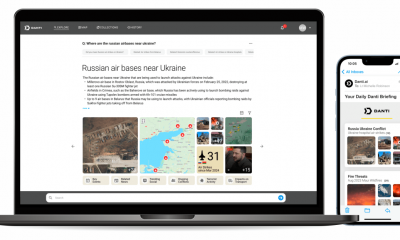Entertainment
How a potential recession will uniquely affect the creator economy

It seems like everyone’s worried about a potential recession. (If you’ve tried to buy eggs recently(Opens in a new window), you’re all too aware of the chaotic state of things.) In a recent poll of economists(Opens in a new window), the World Economic Forum found that nearly two-thirds of respondents believed there will be a recession in 2023, and surveys of economists(Opens in a new window) and business leaders(Opens in a new window) indicate much the same thing. Meanwhile, in December, the Federal Reserve raised interest rates(Opens in a new window) in the most aggressive fashion(Opens in a new window) since the early 1980s; theoretically, if it’s more expensive to borrow money, we’ll spend less, demand will fall, and so will prices. We’ll see what happens next!
There is, however, some soothing news: Even if we do end up in a recession, NPR reports(Opens in a new window) that many analysts expect it won’t be a repeat of 2008 and will instead be “a recession with a small r.” And, if you’re part of the creator economy, which consists of around two million full-time creators and 46 million amateurs(Opens in a new window), or the $16.4 billion(Opens in a new window) influencer marketing industry, maybe you’re not worried at all.
These creators make money in a variety of ways: with sponsored posts (typically netting about $100 per 10,000 followers), by selling merch or their own goods, by using affiliate links, or by making money off of the platforms themselves. They don’t make a ton of money — on average, content creators made $48,800 in 2022, according to Glassdoor(Opens in a new window). But the creator economy is often considered to be recession-proof — or recession-resistant — because it’s driven by direct financial support from audiences, and creators’ ability to connect with fans, which is typically less affected by economic fluctuations.
So, is it time to start updating your YouTube channel? Like everything having to do with the economy, it’s complicated.
Tweet may have been deleted
(opens in a new tab)
(Opens in a new window)
Ads might not slow for creators as much as they slow for others.
During a recession, people’s buying patterns change(Opens in a new window). They’re less willing to pay more for products, and they might be less likely to click on an ad. But Ali Fazal, vice president of marketing at the creator management platform GRIN, told Mashable that people aren’t going to unfollow creators — and they likely aren’t going to stop trusting them, either.
“That’s why we think of the creator economy as being a very recession-proof channel, because in tough economic times, people lean on the relationships that they form, the parasocial relationships with the creators, more than ever,” Fazal said.
Despite the potential — and I can not stress that word enough — of recession, data from Retail TouchPoints,(Opens in a new window) the online publishing network for retail executives, shows that businesses in the U.S. are expected to spend $4.6 billion on influencer marketing in 2023, doubling what they spent just five years ago. More than 65 percent of brands expect to increase their budget for influencer marketing, too. Writing for Fast Company,(Opens in a new window) David Steinberg, founder of marketing technology platform Zeta Global Holdings Corp, says he anticipates a “huge shift toward more effective marketing that is based on individual consumer needs and intent” in 2023. This shift is because, in some part, consumers respond better to influencers than they do to brands. Nielsen’s Consumer Trust Index(Opens in a new window) reports that 92 percent of consumers trust influencer marketing over traditional advertising. That transforms into dollars: A new study shows(Opens in a new window) that 53 percent of people say they’re more likely to buy a product if it’s recommended to them by a member of a community they belong to, like a content creator. And influencer marketing content delivers 11 times better return on investment (ROI) than traditional marketing methods, according to Forbes(Opens in a new window).
In 2023, Steinberg predicts that brands “will begin to view more personalized consumer experiences as content and increase investment in creative after years of focus on media,” and that this era will be focused on vertical-based platforms like Instagram and TikTok. “This new-age, immersive content will be highly engaging and shoppable for consumers, leading to more direct conversions for brands,” he writes.
Ryan Detert, the founder and CEO of Influential, an influencer marketing company, points out that during economic downturn, brands are “very meticulous on the dollars they spend.” Instead of spending big bucks on TV or podcast advertising, they might pivot to spending more on influencer marketing, as it’s cheaper and has been proven to work.
“By and large, the audience is savvy enough to recognize that the reason these creators get to make these incredibly high production-value videos [the audience gets] to watch for free is because the creators are in a financial relationship with the sponsors,” Dave Wiskus, the founder and CEO of Nebula(Opens in a new window), a streaming service for creators, told Mashable. He adds that viewers help pay the creator by signing up for or buying the products they’re sponsoring. Not only do you get something you want — like makeup or a subscription to Better Help — you’re also supporting a creator whose work brings you joy.
Creators can’t depend on ads and sponsorships completely, though.
On YouTube, ad revenue is around $18 per 1,000 ad views(Opens in a new window), which isn’t nearly enough for anyone to live on. If they want to make enough to buy eggs in 2023, they have to also add in sponsorships, but those don’t always come in consistently — especially if a recession hits and brands decide to slash their marketing budgets. Folks need to diversify their revenue streams during a potential economic downturn, Wiskus says. Creators who also do things like offer membership programs, merchandise sales, or digital products may be more resilient to the impact of a recession.
For example, Sarah Renae Clark(Opens in a new window), a YouTuber and content creator, has diversified the ways in which she brings in money by making revenue on ads and sponsored content but also by selling coloring books, planners, color palettes, and other art supplies that go along with her artistic-focused social media channels. It’s one of the reasons she isn’t too worried about a potential recession. She and her husband not only make money from sponsors, but also, they’ve created products that sell to the tune of hundreds of units a day.
“We have found products that our audience needs. So then if there is a recession, I’m not sitting here panicking,” Clark told Mashable. “People aren’t like, ‘Oh, I won’t spend that money because it’s a T-shirt and it’s about supporting your channel.’ They’re not just buying it to support me as a creator, they’re buying it because they want it.”
And even in a recession, people will still buy what they want, or need, the most.
No one is completely safe from a potential economic downturn.
The creator economy isn’t immune to the effects of potential economic downturn — that’s impossible. During a recession, audiences may have less disposable income to spend on creator content and merchandise. Creators might also face increased competition from other creators, as more people turn to online content creation as a source of income, at the same time they are forced to work for less or spend more on what they need in order to create.
Further, while the potential recession is most anticipated to affect the U.S., that doesn’t mean creators in other countries are immune to its effects. Many creators have subscribers, fans, and clients in the U.S., and there are some pretty strong financial links between the U.S. and the rest of the globe.
The Nieman Lab(Opens in a new window) reported that many subscription-based content revenue streams have the potential to slow during a recession — take Patreon, which is abandoning cryptocurrency payment plans because of the “broader economic environment,”(Opens in a new window) and Substack, which told the Financial Times(Opens in a new window) it has “given up on near-term plans to raise further capital to support the business” due to potential economic downturn. Twitch is taking larger cuts from subscription payments; a third of people who pay for media subscriptions are planning to cut back in 2023; and, according to to data from the Dealroom reported by the Financial Times, “investment in the creator economy sector rose from $1.4 billion in 2020 to $3.3 billion in 2021 — before crashing back to $801 million last year ‘as investors became increasingly nervous about frothy valuations in private tech businesses.'”
And yet, the creator economy thrives, with one in four younger(Opens in a new window) Americans saying they want to work as an influencer when they grow up. Another report(Opens in a new window) shows that 86 percent of young Americans are “willing to try out influencing,” 12 percent of young people said they already were influencers, and 20 percent of young people said they personally know an influencer.
The creator economy is still in its infancy. Facebook has only been around since 2004, YouTube since 2005, Instagram since 2010, and TikTok since 2016. And since the creator economy as we know it today hasn’t experienced a recession, it remains to be seen exactly how it will all play out in the long run. Until then, scrolling stays free.
-

 Entertainment7 days ago
Entertainment7 days agoSummer Movie Preview: From ‘Alien’ and ‘Furiosa’ to ‘Deadpool and Wolverine’
-

 Entertainment6 days ago
Entertainment6 days agoWhat’s on the far side of the moon? Not darkness.
-

 Business6 days ago
Business6 days agoHow Rubrik’s IPO paid off big for Greylock VC Asheem Chandna
-

 Business7 days ago
Business7 days agoThoma Bravo to take UK cybersecurity company Darktrace private in $5B deal
-

 Business5 days ago
Business5 days agoTikTok faces a ban in the US, Tesla profits drop and healthcare data leaks
-

 Business5 days ago
Business5 days agoLondon’s first defense tech hackathon brings Ukraine war closer to the city’s startups
-

 Business6 days ago
Business6 days agoPhoto-sharing community EyeEm will license users’ photos to train AI if they don’t delete them
-

 Entertainment7 days ago
Entertainment7 days ago‘Challengers’ review: You’re not ready for Zendaya’s horny love-triangle drama




























